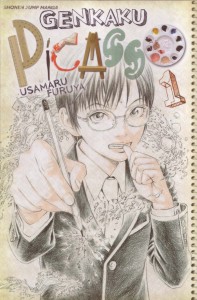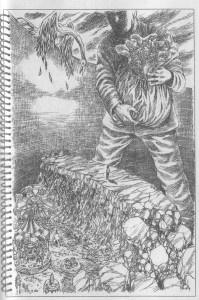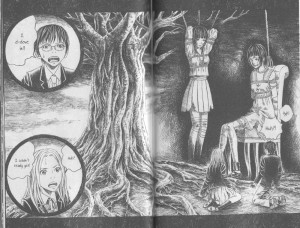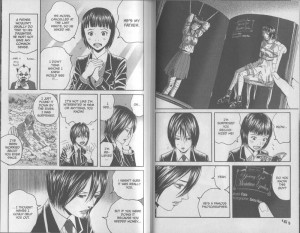A consumer warning. That’s about all this manga deserves. A radioactive label to keep potential customers away from this glistening turd.
But here’s a synopsis for those of a more masochistic disposition: A nerdy, bespectacled student becomes a kind of psychic detective after a near death experience. Saved through the intervention of a girl companion, he achieves a kind of mystical insight (funneled through his artistic abilities) and staves off the clutches of death by helping his school mates through their various childhood traumas.
It should be noted that this comic is produced by one of the more respected alternative cartoonists working in manga today. Usamaru Furuya was first introduced to the English speaking world through his groundbreaking (apparently) but thoroughly underwhelming “Palepoli” in Secret Comics Japan. His most highly rated work in the West may be Garden, an extended meditation on Hieronymus Bosch’s The Garden of Earthly Delights, the attractions of which lie in its extended foray into strange imagery.
This is undoubtedly Furuya’s chief asset as an artist and he deploys this in spurts throughout the work at hand. Furuya’s approach is akin to a type of popular surrealism which owes much to Dali and Magritte, a vision which suffers immeasurably when the personal symbolism at work in them is deciphered and interpreted over the course of his narratives. The following image, for example, portrays a familial misunderstanding about home finances…
…the next some run-of-the-mill introversion as well as a false perception of a female classmate.
I’ve highlighted the latter image because of its connection to Furuya’s single most interesting perversion. The male high school student who is the focus of this particular adventure mistakenly believes that his classmate has been forced to pose for an S&M Lolita magazine because of financial difficulties. In reality, she has willingly acceded to it at the behest of her photographer father. In other words, she’s a happy and well-adjusted girl.
[Not from the manga]
Any parental misdemeanors are shrugged off with a bit of finger (and tongue) wagging in the following panels:
“A father wouldn’t usually do that to his daughter. He must not have any common sense.”
This is probably the height of deviance which Furuya achieves in this comic which was serialized in Jump SQ (a shonen magazine, in case you can’t tell from the age of the protagonist), a kind of artistic premature ejaculation tinged with incestuous longing; a fantasy which still pales in comparison to an aberrant reality where Dario Argento joyfully directed his daughter, Asia Argento, in a rape scene in The Stendhal Syndrome when she was 20.
This furious undercutting of his illustrations with the most insipid of explanations would seem to be Furuya’s acquiescence to commercial dictates; the plodding plotlines the mark of a regurgitating hack. Other stories in this first volume include a standard issue tale of sibling rivalry and another related to some mental trauma due to the loss of a pet bunny in childhood. Both of these tales reflect Furuya’s arid imagination, his inability to cope with any form of long form narrative and his very low opinion of female psychological make-up. Overdosing on television trash like Ghost Whisperer would be preferable to this. Avoid.






Thanks for the review, Suat.
That’s disappointing. Count me as someone who really enjoyed Palepoli, and has been hoping for something newly translated of Furuya’s for a long while. Have you ever read “Marie’s Music” or “Tsuki no Sho”? His interview in “Manga- Masters of the Art” has some pretty interesting illustrations from those stories, along with some pretty revealing quotes regarding his commercialization. I’m also curious about but also repelled by “Emi-Chan”, which looks like it takes some of those personal interests/obsessions you mention above and takes them to their logical conclusions.
You’re talking about a few of the other stories found in his “Garden” collection? I haven’t read most of it, just what’s online.
There’s an old (and glowing) review by Adam Stephanides for those interested in the anthology. Here’s an excerpt: “Although Furuya’s images are not as extreme as Maruo’s (with a few exceptions), three stories in Garden, including the two longest, deal with one of Maruo’s characteristic themes: the abuse, often sexual, of young girls…the subject matters of “Yumenaka” and “Emi-chan” make this unlikely. Even “Moon Letter” might be dicey, as there are depictions of nude children, and one brief implied sex scene. So, while I hate to say that your only hope is to learn to read Japanese, I’m afraid it’s probably true.” (Obviously, Noah would love reading this one.)
From what I’ve seen, Furuya’s work is also much more pornographic than that of Maruo (not using this term in a judgemental way but it’s the best description available). This seems like a deep and abiding interest in young female bodies. Stephanides implied concerns that “Yumenaka” would be considered borderline or frankly paedophilic are not misplaced. No context required. This is a true perversion/obsession. American alternative comics have retreated from this frontier for obvious reasons. What does Furuya say in “Manga Masters of the Art”, Sean?
Looks like you’re right- “Garden” contains Emi-chan and Tsuki no Sho. But Marie’s Music looks like it’s a two-volume standalone series- and the pages I’ve seen from it look very interesting. Another interesting detail about Emi-Chan- apparently when it was reprinted in Garden certain pages could only be read by cutting open sealed pages! Interesting implications regarding participation, especially considering the subject matter…
Well, like most of the interviews in MMOA, it’s mainly softball questions, but he seems both defensive about his current work (it’s titled “Pi” but I can’t find the symbol on my keyboard ^_^;) and very proud of his earliest work.
“Q- So you try to put everything into it, and try to expand your abilities?
A- Yes,, I never do anything halfheartedly, because it is just work. With Pi, some people say I’m not doing my best, but that’s not true. It’s the thing I really want to do the most right now, and I am doing the best experiment for me. When it’s a work that has a good fit for a commercial magazine, people say that kind of thing, but this work is something I very much need to do. All my work is done because I need to do it at that particular time.”
It’s worth noting he’s taking about a series that’s described later in the interview as “a congress of bosoms”. “Furuya was inspired to begin his current series after attending a seminar of doctors and researchers of human mammary glands.”
Furuya-
“In doujinshi, there’s no consciousness of being seen. Without that, it’s basically just like graffitti- words drawn in spray paint on a wall. There’s the impression that one can draw anything frely with doujinshi, but one needs the eye of an audience, and the more strict the eyes are, the more true freedom comes into existence. If it’s free all the way, you can do anything and even the story is destroyed. You aren’t thinking about entertaining the reader. ”
The follow-up question-
“Do you ever feel restricted working in mainstream manga?
A- There is restriction. First of all, nothing like Palepoli can be done. There are also many words you can’t use, and expressions you can’t do.
Q- Are you uneasy with that?
A- If what you want ot do is always a parody or deal with killing or bigotry or those themes, then you might feel uneasy. But that’s just one of the facets I have; I have other images and themes, so I don’t have to use those, that’s all… so I don’t feel uneasy.”
Lastly, it’s very interesting to think that Emi-Chan, and the rest of his work until 2004, were produced by someone working as a high school art teacher. Both interesting in an “how in the world did he manage to find the time?” but also to reflect that, in the U.S., there are stories every year of teachers getting fired for things very innocuous (such as loaning “Ice Haven” to a fifteen year old student.)
All of that sounds very applicable to Genkaku Picasso. Of course, there’s no way he’s going to entertain people with tedious rehashings. I presume the commercial stuff also helps to pay the bills. Another Secret Comics Japan contributor, Aida Makoto (of Mutant Hanako), seems to be doing more fine art (?). Very similar obsessions if you check Google images. Saw one of them at the local Biennale.
Damn. This is worse than “Ghost Whisperer?” I have a hard time believing that’s possible.
That cover brings out my inner bully – I kinda want to punch that kid in the face. Maybe it’s the resemblance to that punk, Harry Potter.
“This furious undercutting of his illustrations with the most insipid of explanations would seem to be Furuya’s acquiescence to commercial dictates”
Try Furuya’s Lychee Light Club, coming next year from Vertical. It’s full-on ero-guro (an adaptation of a Tokyo Grand Guignol play, in fact), and far weirder and more disturbing than anything Jump SQ would allow. (Keep out of reach of children, not to be read by persons of a sensitive disposition, consult doctor if mental distress persists for more than seven days, etc.)
JRB: I’ll look out for Lychee Light Club. You can’t go wrong with ero-guro, right?
Richard: “This is worse than “Ghost Whisperer?” I have a hard time believing that’s possible.”
Believe. It helps if you switch channels after watching 5 minutes of the show.
“Marie’s Music” has been scanlated and seems to receive praise from anyone who read it. It, like some other works of Furuya, has been published in Taiwan.
I’ve read the opening chapters of the Taiwanese version of “Pi”, so I know it’s a comedy about a dorky teenage genius’s life, but don’t know what else it has to offer. The title “Pi” refers to the protagonist’s obsession with finding the perfect breasts.
Oh, of course Marie’s Music has been published in France, but you must already know that.
Ah…thanks for the reminder. Marie’s Music is pleasant enough but I wouldn’t hold it up as great (or even very good) manga. But, yes, absolutely preferable to Genkaku Picasso in just about every way. Sort of reminds me of the tone of some Japanese RPGs and semi-plotless anime for much of its first volume; a lot of world building to fill up the pages. A sprinkling of Christian-Catholic imagery and overly familiar conceptions of “god” as well (the Japanese seem to love the sort of thing found here). I see quite a few variations on real life religious ceremonies, mythology and artistic creations (the Haj, Da Vinci etc.), so a latter day earth filled with humanistic optimism. It’s a bit saccharine in parts and relies too much on “big” reveals especially towards its close (no elaboration here for the benefit of those who intend to read the manga). I think Furuya would do well as a concept artist for a game or movie, and Marie’s Music would work well if trimmed down to a standard length anime movie. It would be a real tear jerker.
Unfortunately, I can’t disagree with you about Genkaku Picasso. I don’t agree that it reflects “Furuya’s arid imagination,” though. Even just looking at his most recent stuff, he has two other series currently running, No Longer Human and The Children’s Crusade, which are much better.
I’ve seen stuff by Maruo which is much more pornographic than anything I’ve seen by Furuya. Mr. Arashi’s Amazing Freak Show, which I guess is his best-known work in the U.S., is restrained for Maruo. If you can find a copy of Ultra Gash Inferno, the stories in there are a lot harder.
Richard, if you ever read Genkaku Picasso, you’ll want to punch the main character even more. He’s an unlikable jerk.
Hi, Adam. I have a copy of Ultra Gash Inferno and did a short flip after reading your review. Perhaps, “pornographic” was the wrong word to use. I think Furuya’s work here is probably meant to be more titillating than that of Maruo’s. But I suppose your mileage may vary. Maruo’s work would probably be considered much more obscene by the general populace than anything by Furuya.
Pingback: Off the Cuff: Short Cuts and Genkaku Picasso « The Manga Critic
I didn’t mind what I read of Furuya’s Short Cuts. It’s the opposite of your description, of “Genkaku.” Short gag based pages and relatively tame. Not all of it worked, but the idea of a Kogal as Greek Chorus I thought was pretty clever. Wouldn’t mind seeing American cartoonists doing the same thing with “valley girls.” It’d be the new version of “Zippy the Pinhead.”
Pingback: Tweets that mention Bromidic Manga: Genkaku Picasso « The Hooded Utilitarian -- Topsy.com
Pingback: Usamaru Furuya Manga Moveable Feast: Archive